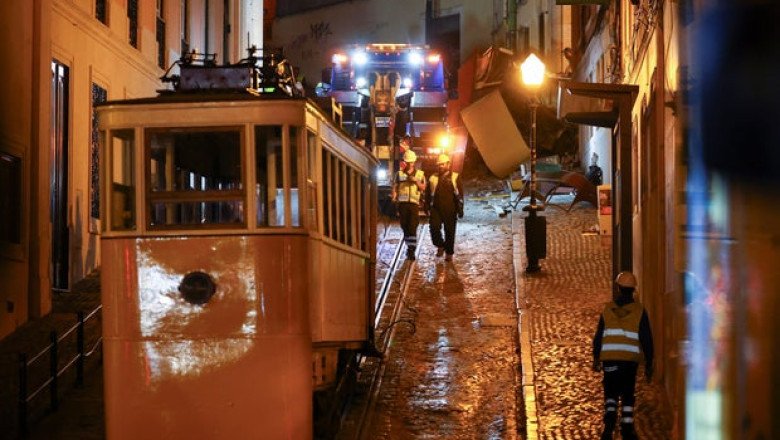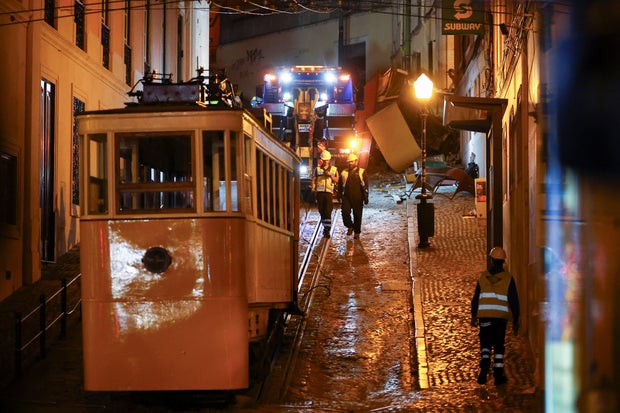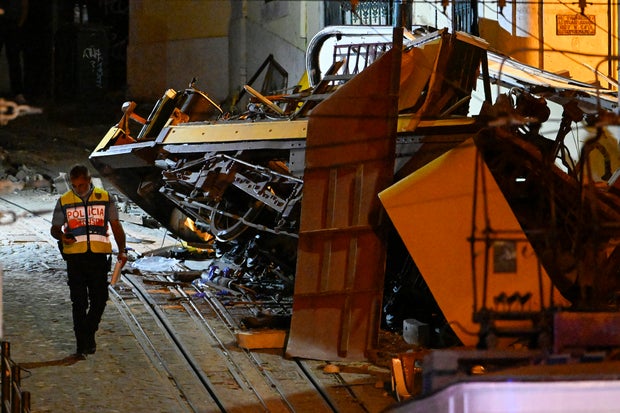
views
Lisbon — Two days after Portugal’s worst-ever electric streetcar crash killed 16 people and left more than 20 others from across the globe injured, forensics teams in Lisbon said Friday that they had identified nearly all of the victims, many of whom were crushed to death when the famed Elevador da Gloria funicular hurtled out of control down a steep hill, derailed and careened into a building.
While names have not yet been disclosed, Portugal’s attorney-general said Friday morning that the death toll includes two South Koreans, two Swiss nationals, one French national and five Portuguese citizens.
A U.S. State Department spokesperson confirmed to CBS News on Thursday that one American was also among the 16 people killed, but they did not identify the victim.
“Our staff in Lisbon and here in the United States are working tirelessly to provide consular assistance to the victim and their family. We extend our condolences to the victims and families of all those affected,” the official said. “The Embassy is working closely with local authorities to assist U.S. citizens in the affected area, and continues to monitor the situation closely. Due to privacy considerations, we have no additional details at this time.”
People work at the site of the derailment and crash of the Gloria funicular railway car, a popular tourist attraction, which resulted in multiple casualties, in Lisbon, Portugal, Sept. 4, 2025. Wreckage of the upper carriage can be seen behind the still-intact lower carriage in the foreground. Pedro Nunes/REUTERS 
There is also “a high possibility,” based on recovered documents and other evidence, that the victims include two Canadians, one German and one Ukrainian, according to the head of the national investigative police, Luís Neves. CBS News’ partner network BBC News said Friday that Portuguese police believed three British nationals were also among those killed.
At least 21 other passengers were injured, including people from Portugal, Spain, Israel, Brazil, Italy and France, according to the head of Portugal’s National Health Service.
Millions of people ride Lisbon’s iconic yellow-and-white funicular cars each year. It’s a popular experience for foreign tourists, and the Elevador da Gloria, at almost 140 years old, has long been a big attraction. In 2024, an estimated 29 million foreigners visited Portugal, many passing through the capital and its quiet, cobblestone streets and hills.
But the electric street cars and hillside funiculars are also part of everyday life for many locals.
A Portuguese charity based on the hill near the top of the Elevador da Gloria funicular confirmed Friday that four of its employees were killed in the accident. They were believed to have been commuting from work.
“We have lost colleagues, friends and the people who we shared our daily lives as well as our mission”, the Santa Casa da Misericordia said in a statement. “We’re in a state of shock.”
A police officer walks past the wrecked Elevador da Gloria funicular at the scene where it derailed, Sept, 3, 2025 in Lisbon, Portugal. Horacio Villalobos/Getty 
Portugal’s President Marcelo Rebelo de Sousa, Prime Minister Luis Montenegro and Lisbon Mayor Carlos Moedas attended a Mass in the early evening on Thursday near the site of the crash. Speaking to reporters outside the church, Rebelo de Sousa said: “This is a time of mourning. It’s the moment to mourn the dead… pray and think of the dead, and to support their friends and family.”
The president also called for a clarification of the causes of the accident “as quickly as possible.”
After midnight on Friday, and with few onlookers, workers lifted the mangled wreckage of the Elevador da Gloria car that crashed.
As with most funiculars, two carriages linked by a steel cable operate in tandem: One carriage climbs up the hill as the other trundles slowly down. Early Wednesday evening, many people believe that cable snapped, causing the tragedy.
Portuguese media showed officials inspecting the frayed ends of the cable that had connected the cars, which they had pulled up from underground, on Friday. According to a fire brigade official, the car coming down from the top of the hill was not able to slow down, entered a curve in the hill too fast, derailed, and then plowed into the cobblestone pavement and crashed.
Cable and brake failures are two of the most common causes of streetcar accidents.
The president of the Portuguese Order of the Engineers, Almeis Santos, told CBS News the accident appeared to have been caused by the rupture of the cable.
“It’s very strange… for this kind of cable. It’s not normal and it’s almost impossible to have [a] sudden rupture,” he said.
Tourists wait to board the Elevador da Gloria funicular, one of the funiculars operated by Carris in Lisbon, Portugal, in a May 24, 2024 file photo. Horacio Villalobos/Corbis/via Getty 
Santos said if the cable did snap suddenly, neither the manual nor automatic brakes on the funicular would have been sufficient to hold back the streetcars, which, when loaded with passengers weigh around 20 tons each.
Carris, the company that operates the Elevador da Gloria, has said regular inspections — including daily checks — had been carried out as required.
Portugal’s Air and Rail Accident Investigation Unit was expected to release a preliminary report on the technical cause of the funicular crash later Friday. In 45 days, Portugal’s national police will then issue their report on any potential criminality involved in the crash.
The mayor said Lisbon and its three million residents would observe three days of mourning following the disaster.
More from CBS News
Ramy Inocencio is a CBS News foreign correspondent based in London, covering Europe and the Middle East. He joined the Network in 2019 as CBS News’ Asia correspondent, based in Beijing and reporting across the Asia-Pacific, bringing two decades of experience working and traveling between Asia and the United States.
https://wol.com/lisbon-funicular-crash-victims-nationalities-slowly-emerge-after-portugal-streetcar-disaster-that-killed-16/























Comments
0 comment